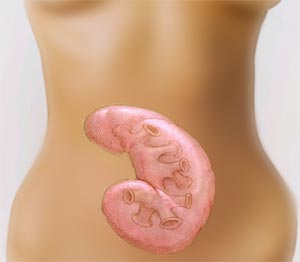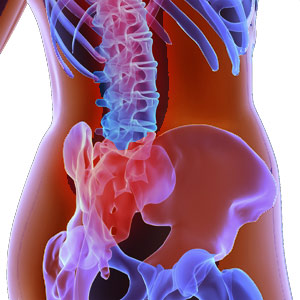Urinary Incontinence in Women

Loss of bladder control is referred to as urinary incontinence. In United States alone, more than thirteen million people suffer from this inability to hold or control urine. These people have trouble controlling their urination so much so that even when they cough or sneeze, they feel the urgent and sudden need to go to the toilet to urinate. Urinary incontinence can occur among male and female, old and young. Learn more about the causes for urinary incontinence and stress urinary incontinence.
How does urinary incontinence occur?
During urination, the muscles in the wall of the urinary bladder contract. This forces the urine out of the bladder and into the urethra. Simultaneously, the sphincter muscles surrounding the urethra relax, letting urine pass out of the body. Urinary incontinence occurs if the bladder muscles suddenly contract or muscles surrounding the urethra suddenly relax.
Urinary incontinence in women
Women experience urinary incontinence twice as often as men. Various factors like pregnancy and childbirth, menopause and the structure of the female urinary tract account for this difference. Urinary incontinence is noticed much more among older than younger women. Incontinence occurs in women usually because of the problems with muscles that help to hold or release urine.
Types of urinary incontinence in women
Stress incontinence: If a woman suffers urinary incontinence even during coughing, sneezing or other movements, it is likely due to stress incontinence. Physical changes resulting from pregnancy, childbirth, and menopause often cause stress incontinence. This is the commonest cause for incontinence in women and is treatable.
- The pelvic muscles that support the bladder do not shut the urethra squeeze as tightly as they should, when they become weak. Consequently, urine leak into the urethra is felt during moments of physical stress.
- Stress incontinence also occurs if the muscles that do the squeezing weaken.
- Stress incontinence is seen to worsen before the menstrual period. This is due to lowered estrogen levels that lead to lower muscular pressure around the urethra thereby increasing the chances of leakage.
- Stress incontinence increases in women following menopause.
Urge incontinence: Here one loses urine even while suddenly feeling the urge to urinate. The common cause of urge incontinence is due to inappropriate bladder contractions. Urge incontinence is also referred to as unstable or overactive incontinence. This condition is also called 'reflex incontinence'. This is the result of overactive nerves controlling the bladder.
- Urge incontinence can result in emptying the bladder during sleep after drinking a small amount of water. People suffering from urge incontinence can release urine even if they touch water or hear water running.
- Multiple sclerosis, Parkinson's disease, Alzheimer's disease, stroke and injury can harm the bladder nerves or muscles and result in urge incontinence.
Functional incontinence: People with problems thinking, moving or communicating that prevent them from reaching a toilet suffer from functional incontinence. For example, a person with Alzheimer's disease may not think well enough to plan to reach the toilet well on time.
Elderly women in nursing homes or a patient in wheel chair may be blocked from getting to a toilet in time. Functional incontinence is often associated with age.In women, the stress and urge incontinence occur together most of the times.
Overflow incontinence: When the bladder is so full that it frequently leaks urine, it is overflow incontinence. Weak bladder muscles or a blocked urethra causes this type of incontinence.
- Usually nerve damage due to diabetes or other diseases can lead to weakening of bladder muscles.
- Tumors and urinary stones can also block the urethra and contribute for overflow incontinence.
- This kind of incontinence is however rare in women.
Transient incontinence is temporary and triggered by medications, urinary tract infections, mental impairment and restricted mobility and stool impaction, which push against the urinary tract and obstruct over flow.
Reflex incontinence: This type of incontinence occurs among people with injury to the nervous system such as paralysis from spinal cord injury that affects the nerves that run to the bladder. This type of people experience urine loss without any sensation or warning at all.
Total incontinence: Continuous leak of urine, day and night or periodic large volumes of urine accompanied by uncontrollable leaking is called total incontinence. Anatomical defect can cause this type of incontinence. Spinal cord injury or injury to the urinary system from surgery can cause total incontinence.
Nocturnal enuresis: Nighttime bed-wetting is medically termed as nocturnal enuresis. Young boys who are otherwise toilet trained wet their beds in the night for a range of reasons. Sometimes adults can also lose control of their bladder at night due to excessive alcohol or medications. Aging is also likely to cause difficulty in storing urine at night because of an abnormally high production of urine at night.
Causes of urinary incontinence
- Consuming alcohol in excess is one important cause. Alcohol causes the bladder to fill quickly and triggers an urgent and uncontrollable urination. Alcohol also temporarily impairs the ability to recognize the need to urinate and act in a timely manner.
- Drinking a lot of fluid or any other beverages in a short period of time increases the amount of urine in the bladder which results in urinary incontinence.
- Caffeine is a diuretic. It causes your bladder to fill more quickly than usual resulting in sudden and uncontrollable need to urinate.
- Consuming foods and beverages that irritate your bladder like carbonated drinks, tea and coffee may cause episodes of urge incontinence. Citrus fruits and juices and artificial sweeteners also can be sources of aggravation.
- Sedatives such as sleeping pills can interfere with your ability to control bladder function. Water pills like diuretics, muscle relaxants and antidepressants can cause an increase in urinary incontinence. High blood pressure drugs, heart medications and cold medicines also affect the urinary bladder function.
- Urinary tract infection can cause bladder irritation and even incontinence.
- Constipation in the rectum causes nerves to be overactive.
Causes of persistent urinary incontinence in women
Pregnancy and childbirth: As indicated earlier, pregnant woman experience stress incontinence because of hormonal changes and increased weight of an enlarged uterus. The stress of childbirth also weakens the pelvic floor muscles and the ring of muscles that surround the urethra. Urine escapes past the weakened muscles whenever pressure is placed in your bladder.
Hysterectomy: In woman the bladder and uterus lie close to each other. They are both supported by the same muscles and ligaments. Any surgery like hysterectomy runs the risk of damaging the muscles or nerves of the urinary tract which can lead to incontinence.
Menopause: After menopause a woman's body produces less of hormone estrogen. This drop in estrogen can contribute to incontinence in women.
Cystitis: A chronic condition called interstitial cystitis usually affects women more often than men.
Causes of persistent urinary incontinence in men
Prostatitis can sometimes lead to incontinence. Enlarged prostrate in older men, a condition known as benign prostatic hyperplasia can cause constriction of the urethra and block the flow of urine. Prostrate cancer, which is untreated in men, is the cause of incontinence. Urinary incontinence is also a side effect of treatments like surgery or radiation for prostrate cancer. Cancer of the bladder causes urinary urgency and burning with urination.
Diagnosis of urinary incontinence
To evaluate the capacity of the bladder and the residual urine for evidence of poorly functioning bladder muscles, the doctor asks the patient to consume plenty of water and other fluids and urinate into a measuring pan. The doctor also recommends some of the following tests:
- Stress test is done to watch for loss of urine when the patient relaxes or coughs.
- Urinalysis is a test for evidence of infection, urinary stones or other contributing causes.
- Blood tests are done to examine the substances related to causes of incontinence.
- Ultrasound is used to see the kidneys, ureters, bladder and urethra.
- Cystoscopy is inserted into the urethra and the inside of the urethra and bladder is examined.
- Urodynamics consists of various techniques that help measure pressure in the bladder and the flow of urine.
Treatment for urinary incontinence in women
- Exercises help to strengthen pelvic floor muscles and sphincter muscles. This can reduce and cure stress leakage.
- Sometimes brief doses of electrical stimulation can strengthen muscles in the lower pelvis in a way quite similar to exercising. Electrical stimulation is used to reduce stress incontinence and urge incontinence.
- Some medications help to relax muscles leading to a more complete bladder emptying during urination. Some drugs help to tighten muscles at the bladder neck and urethra preventing leakage. Hormones such as estrogen cause muscles involves in urination to function normally.
- Implants are injected into the tissues around the urethra. These implants ad bulk and help to close the urethra to reduce stress incontinence. Collagen from cows and fat from patient's body are normally used for implantation by local anesthesia. Implants have only partial success rate and needs to be repeated after a time as the human body is bound to slowly eliminate the substances.
- Surgery is suggested to alleviate incontinence only after other methods and treatments have failed. Surgical options however have a high rate of success for curing urinary incontinence.
- Catheterization is used when the bladder never empties completely or when the bladder cannot empty because of poor muscle tones post surgery.
Top of the Page: Urinary Incontinence in Women
Tags:#urinary incontinence #stress urinary incontinence #urinary incontinence treatment #male urinary incontinence #female urinary incontinence #urinary incontinence surgery #causes urinary incontinence
 Pelvic Floor Dysfunction
Pelvic Floor Dysfunction Bladder problems in women
Urinary Incontinence
UTI - Urinary Tract Infection
Feminine Hygiene
Yeast Allergy
Other health topics in TargetWoman Women Health section:
General Women Health

Women Health Tips - Women Health - key to understanding your health ...
Cardiac Care
Women's Heart Attack Symptoms - Identify heart problems...
Skin Diseases
Stress Hives - Red itchy spots ...
Women Disorders
Endocrine Disorder - Play a key role in overall wellbeing ...
Women's Reproductive Health
Testosterone Cream for Women - Hormone replacement option ...
Pregnancy
Pregnancy - Regulate your lifestyle to accommodate the needs of pregnancy ...
Head and Face
Sinus Infection - Nearly 1 of every 7 Americans suffer from ....
Women and Bone Care

Slipped Disc - Prevent injury, reduce pain ...
Menstrual Disorders
Enlarged Uterus - Uterus larger than normal size ...
Female Urinary Problems
Bladder Problems in Women - Treatable and curable ...
Gastrointestinal Disorders
Causes of Stomach Ulcers - Burning feeling in the gut ...
Respiratory Disorders
Lung function Test - How well do you breathe ...
Sleep Management

Insomnia and Weight Gain - Sleep it off ...
Psychological Disorders in Women
Mood swings and women - Not going crazy ...
Supplements for Women
Women's Vitamins - Wellness needs...
Natural Remedies

Natural Diuretic - Flush out toxins ...
Alternative Therapy
Acupuncture Point - Feel the pins and needles ...
Women Health Directory
Top of the Page: Urinary Incontinence in Women
Popularity Index: 101,037

